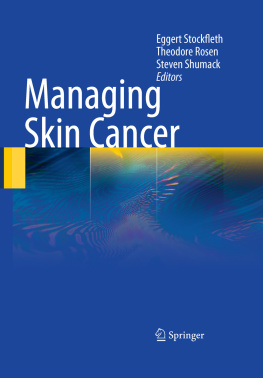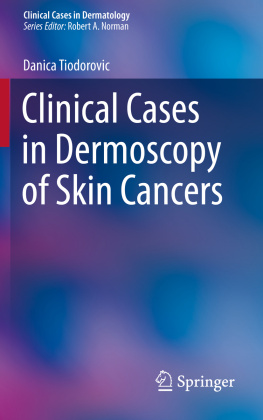11.1 Introduction
Although often collectively named keratinocyte skin cancers or less specifically non-melanoma skin cancers, basal cell carcinoma (BCC) and squamous cell carcinoma (SCC) are two quite different skin cancer types each with distinct epidemiological features, ranging from different typical age of onset, to different mortality rates, to different causal pathways.
BCC and SCC do have in common that most of the information about their occurrence and risk factors is obtained from ad hoc research studies, because most cancer registries do not routinely report skin cancers apart from melanoma. This chapter summarises the epidemiological features of BCC and SCC and briefly discusses the main factors associated with occurrence of these skin cancers.
Treatment costs of keratinocyte skin cancers are very high in countries with predominantly white-skinned populations, with an annual cost of US $13 billion in the USA alone []. Although fatality from BCC and SCC is low, the many patients affected by these cancers may experience discomfort and scarring and require follow-up to detect recurrence or spread. Thus the disproportionately large medical costs associated with treatment of BCC and SCC warrant continued research to increase understanding of their natural history, for better treatment, and to identify cost-effective prevention measures.
11.2 Basal Cell Carcinoma Epidemiology
11.2.1 Geographic Variation
BCC predominantly occurs in white-skinned individuals, and the strong correlation between latitude and incidence of this cancer reflects the important role of sunlight exposure in its aetiology. Incidence of BCC in the USA is almost 14 times higher in whites than in Hispanics []), probably due to regional differences in skin colour within Caucasians.
11.2.2 Temporal Trends
Many countries that are commonly affected by BCC have reported large increases in BCC incidence over the past decades, and these increases often vary by age-group. In parts of Western Europe, BCC incidence rates have increased by as much as two to threefold during the last three decades (reviewed in [], BCC incidence has particularly risen in young women in the last three decades.
In Australia, age-standardised incidence rates of BCC have increased only by a third in the last two decades [].
11.2.3 Age and Sex Distributions
Incidence of BCC increases steadily with age, with BCC rarely occurring in persons younger than 30 years, even in high-risk populations such as Australia [].
In most affected populations there is a different age-related incidence pattern between males and females. Below the fifth decade of life, women tend to be affected more often by BCC than men, but in older ages men are more commonly affected [].
11.2.4 Incidence by Anatomical Site
In both sexes, BCCs occur most commonly on the head or neck, followed by the trunk, and upper limbs and lower limbs [].
In terms of the distribution of different BCC sub-types on body sites, the evidence is inconsistent. Studies from the Netherlands [] have shown more equal distributions of superficial BCC between trunk and head/neck.
Interpretation of these site distributions is further complicated by the observation that despite the possible predilection of the superficial BCC sub-type for the trunk, nodular BCCs predominated over superficial BCCs on the trunk in the South Australian series [], but further evidence is needed to confirm this.
When interpreting studies of the site distribution of BCC sub-types it is important to keep in mind that most of these have been based on retrospective reviews of hospital records. Such results can be biased by dependency of referral patterns on histological sub-types and body site of occurrence. Also, bias may be caused by differential management of different body sites and lesion types and subsequent opportunities for histological identification. Thus further evidence from population series and from molecular investigations is needed to elucidate the biology of the different BCC sub-types.
11.2.5 Repeated Occurrence
Patients affected by BCC are at high risk of subsequent BCCs. Based on a meta-analysis of 17 studies it was estimated that a person has a 44% risk of a subsequent BCC within 3 years after a first BCC, about ten times the incidence rate expected in the general population [].
11.3 Squamous Cell Carcinoma Epidemiology
11.3.1 Geographic Variation
Like BCC, SCC is predominantly a cancer that occurs in white-skinned people, with incidence rates varying strongly between countries. At a population level, SCC tumors occur less frequently than BCC tumors. Incidence rates can also vary strongly between population sub-groups according to skin colour. For example, SCC incidence rates in the USA are almost 11 times higher in whites than in Hispanics [].
Lifetime risk of SCC is high particularly in high-risk countries such as Australia, where the estimated risk of developing an SCC by age 70 is 28% and age-standardised incidence rate for SCC is 387 per 100,000 [].
11.3.2 Temporal Trends
Many countries in Europe [], but such a declining trend is not seen in data from other countries.
11.3.3 Age and Sex Distributions
As for BCC, the incidence of SCC increases with increasing age. Up to the fifth decade of life, women tend to be more commonly affected by SCC than men, but in older age incidence rates of SCC are generally much higher in men than in women [], suggesting that any difference in sun-exposure behaviour that may underlie these sex differences plays less of a role in very high compared to lower sunlight environments.
11.3.4 Incidence by Anatomical Site
The head and neck are the most common sites of occurrence for SCC in both men and women, followed by the neck and upper and lower limbs [].
11.3.5 Repeated Occurrence
Patients affected by SCC are at high risk of subsequent SCC lesions. The general risk of a subsequent SCC after a first diagnosis has been estimated from published studies to be about 18% after 3 years, at least a tenfold increase in incidence compared with the incidence of first tumors in a comparable general population [].
11.3.6 Actinic Keratoses
Actinic keratoses (AKs) are benign keratotic tumors, with only a very small proportion progressing to become SCC. Over time, actinic keratoses can clear spontaneously, persist [].
There are no published population-based incidence rates of people who develop actinic keratoses and this would be difficult to calculate given the lability of these lesions. However, in a follow-up study of adults in southern Australia who were initially lesion-free, 19% had a prevalent actinic keratosis at 12 months follow-up [].













